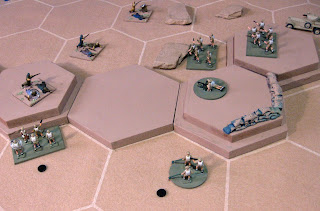This scenario is inspired by chapter 27 of Donald Featherstone's book, Campaigns for Wargamers, except that mine is a single action in the valley rather than a complete campaign.
My scenario sees the notorious Malik-Ghazi tribe being responsible for a number of raids on convoys passing close to the Pushna Valley. Three weeks ago, a convoy of military stores was attacked and plundered. Included in the cargo were Lee Enfield rifles, Vickers machineguns and artilley and small arms ammunition. All of this is now in the hands of the Malik-Ghazis.
2nd Battalion Grampian Highlanders has been tasked to attack and destroy the base of the Malik Ghazis, which is located in the mud fort at the head of the Pushna Valley. The tribesmen are now very well armed, although not well trained, but they are adept at making improvised weapons and fortifications.
The valley is a strong defensive area, with the only vehicle route running through the valley floor. Beyond he valley the terrain is very rocky and difficult. Here are some views of the valley and intelligence reports indicate that the high valley walls are defended with sangars and the valley floor has improvised mines made from the looted artillery shells:
The head of the valley is defended by a mud fort:
The British force consists of A & B companies of the Grampian Highlanders (GHldrs), with HQ and Support Company elements, including two Vickers sections, a 3" mortar section and two troops of Royal Engineers. The force has a squadron from the Chiltern Hussars, equipped with machinegun armed Rolls Royce armoured cars:
The British plan is to sieze the two high bluffs on each side of the entrance of the valley then roll up the Malik-Ghazi positions on the two ridges. Once achieved a two pronged attack against the fort will begin. CO GHldrs has forbidden the armoured cars to enter the valley proper until the engineers have cleared any mines.
The attack begins as the two companies, bagpipes playing, advance towards the bluffs supported by mortar and machinegun fire:
The tribesmen in the rocks at the foot of the bluff are quickly cleared but soon intense fighting begins as the GHldrs work their way in closer and up onto the ridge
Casualties are quite heavy and one platoon is destroyed by fire coming from the sangars, however, with the heavy weight of machine gun fire the Malik-Ghazi forward positions fall:
After more casualties and a couple of setbacks, under heavy fire, both bluffs are captured:
With the threat from the high ground reduced the engineers begin to clear the mines:
Slowly the resistance on the valley walls reduces as positions are abandoned by the tribesmen, although they continue to cause casualties amongst the British:
The two Malik-Ghazi machine guns create a cross fire that cuts down HQ Company, but the CO, who has moved too far ahead of his troops is fortunately not hit and the pipes continue to play. The mortars are brought to bear against the machinegun postions as infantry work along the ridge:
The machineguns are cleared and most of the tribesmen have withdrawn or fled back towards the fort having lost many men. At the same time the engineers have cleared a path through the valley, somehow not gaining any casualties.
The armoured cars move forward and bring heavy fire onto the defenders in the fort:
With mortar fire raining down on the mud fort the tribesmen decide they have had enough and run off into the countryside beyond. Trucks with explosives are brought up and the British blow up the fort and the arms and ammunition looted earlier.
A win for the British, although all platoons have sustained some casualties and HQ Company has been severely mauled.
All of the figures (apart from 2-3) are by Airfix and the armoured cars are laser printed. The fort is scratch built made from scrap MDF and matchsticks.


















































